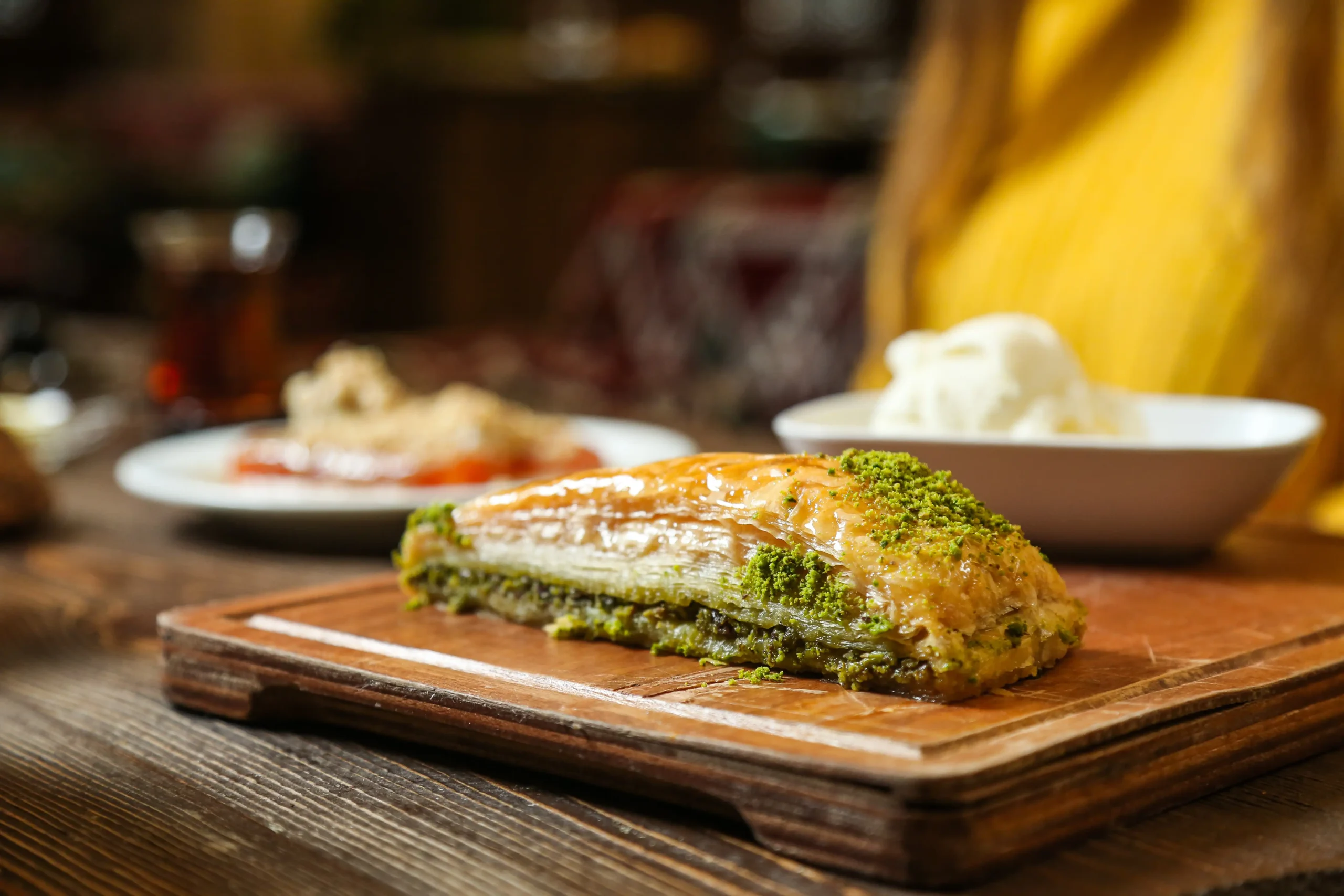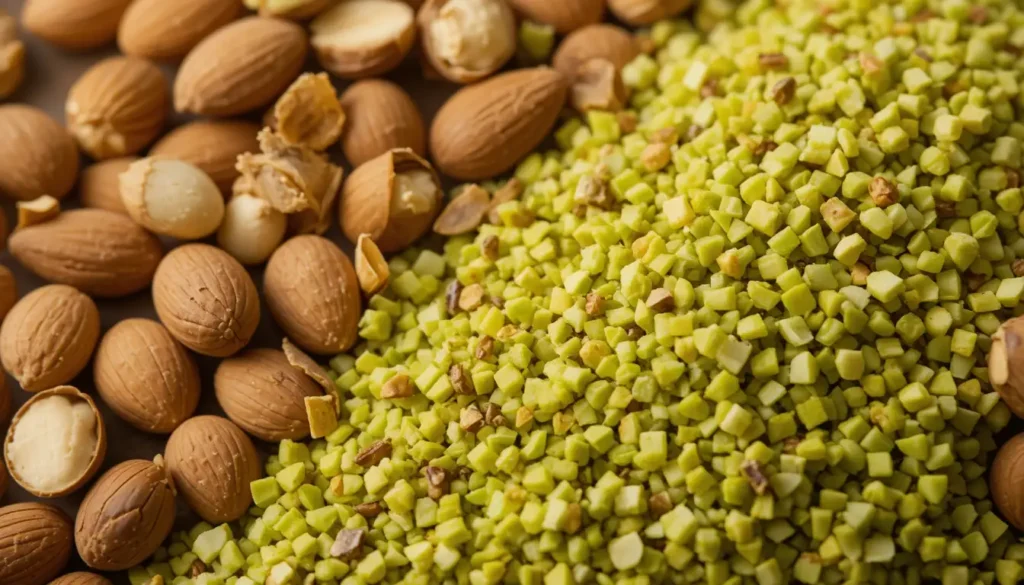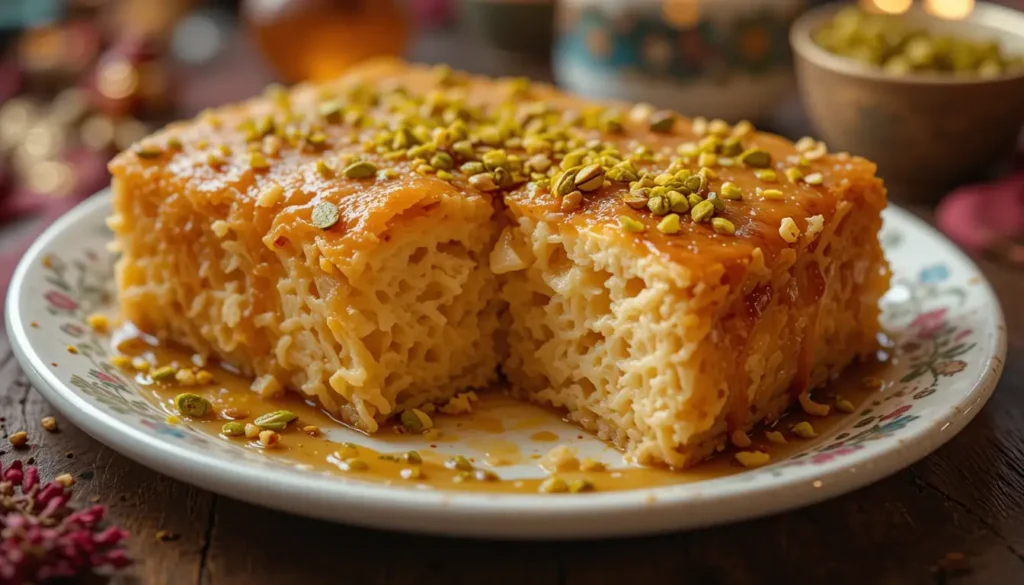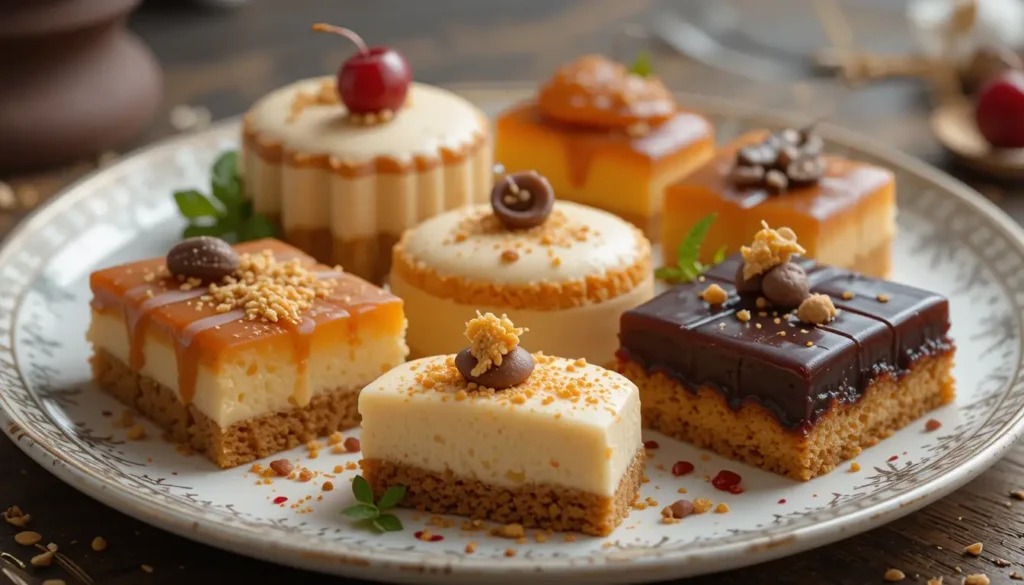Arabic desserts deeply intertwine with the cultural fabric of the Arab world. They are not just about flavor; they carry a sense of tradition, hospitality, and celebration. Arabic sweets often feature in major religious festivals like Eid, Ramadan, and weddings. Families and communities share them as symbols of generosity and togetherness.
The most famous Arabic desserts use ingredients like honey, nuts, rose water, and syrup, creating sweets that are both rich and aromatic. Many of these desserts date back centuries, influenced by the region’s history, including the rise and fall of empires, trade routes, and cultural exchanges. Whether it’s a flaky pastry, a syrup-soaked cake, or a nut-filled treat, Arabic desserts have something to offer every palate.
While the list of famous Arabic desserts is long, one of the most iconic and widely enjoyed is Baklava. However, other favorites like Kunafa, Basbousa, and Ma’amoul are just as deserving of recognition. Let’s delve into these desserts and explore why they are so cherished.
Table of Contents
Baklava – The Star of Arabic Desserts

What Makes Baklava So Special?
Among all Arabic desserts, Baklava is arguably the most famous and widely loved. This indulgent treat is a combination of phyllo dough, chopped nuts, and sweet syrup. Its golden, crispy texture contrasts perfectly with the rich, nutty filling, and the syrup-soaked layers make it irresistible.
If you’re exploring luxurious treats, try making the Dubai Chocolate Bar Recipe at home for a unique Arabic-inspired dessert.
Baklava often associates with the Ottoman Empire, which spanned vast regions of the Middle East, Mediterranean, and Eastern Europe. Over time, the dessert became a symbol of wealth and hospitality, often served at banquets and celebrations. Today, people around the world enjoy it, with each country adding its own twist to the classic recipe.
The Ingredients of Baklava
The magic behind Baklava lies in its simple yet effective combination of ingredients. Each component plays a key role in the final product’s flavor and texture. Let’s break down these ingredients:
- Phyllo dough: This delicate, thin dough is key to creating the flaky, crispy texture that defines Baklava. When layered and baked, it creates the signature crunch.
- Nuts: The filling of Baklava is typically made with pistachios, walnuts, or almonds, giving the dessert its rich, nutty flavor. The choice of nuts may vary based on regional preferences.
- Butter: Generously brushed between the layers of dough, butter contributes to the golden-brown color and adds richness to the dessert.
- Sugar and honey syrup: Once baked, the pastry is soaked in a syrup made from sugar, water, and honey. This syrup adds a sweet, sticky finish, making Baklava truly indulgent.
What makes Baklava even more exciting is its versatility. In some regions, cooks flavor it with rose water or orange blossom water to enhance its aromatic qualities. The syrup may also include a hint of lemon juice or cinnamon, which balances the sweetness and adds complexity to the flavor.
Other Famous Arabic Desserts
While Baklava is the most famous, Arabic cuisine offers a wide variety of other delicious desserts. These treats vary by region, but they share similar ingredients and flavors, often utilizing nuts, syrup, and sweet dough.
Kunafa
One of the most beloved desserts in the Arab world is Kunafa. This dessert uses shredded phyllo dough or semolina dough and fills it with a creamy cheese, such as Nabulsi cheese, or custard. The dough bakes until golden, then soaks in a fragrant sugar syrup. Kunafa typically gets served warm and is often garnished with crushed pistachios.
Kunafa has different variations depending on the country, but its rich texture and syrupy sweetness make it a favorite during Ramadan and other festive occasions.
Basbousa (Hareeseh)
Basbousa, also known as Hareeseh, is a semolina cake that soaks up a syrup made from sugar and water, often flavored with rose water or orange blossom water. This cake is simple to make but incredibly delicious. Its soft, spongy texture and aromatic sweetness make it a favorite in many Arab homes.
In some regions, cooks add yogurt to the batter, which gives Basbousa a richer flavor and more moisture. Bakers often cut this dessert into squares or diamonds and top it with blanched almonds before baking.
Ma’amoul
Another iconic Arabic dessert is Ma’amoul, a shortbread-like cookie filled with dates, figs, or walnuts. People traditionally prepare these cookies during holidays like Eid al-Fitr, shaping them using special wooden molds to create intricate patterns. Bakers often dust Ma’amoul with powdered sugar, and it is enjoyed with a cup of Arabic coffee or tea.
Ma’amoul boasts a rich history and symbolizes generosity in Arabic culture. It is often shared among family and friends during celebrations.
The Ingredients Behind Arabic Sweets
Arabic desserts are known for their unique and indulgent flavors, which often come from a mix of simple yet distinct ingredients. While the recipes may vary by region and specific dessert, there are common ingredients that form the base of most Arabic sweets. Let’s take a closer look at some of the most important ingredients that make these desserts so special.

The Role of Nuts in Arabic Desserts
Nuts are a staple in many Arabic desserts, and their role extends beyond just flavor—they add texture, richness, and a touch of luxury to the sweets. Commonly used nuts in Arabic sweets include pistachios, almonds, and walnuts. These nuts bring a natural sweetness and crunch that balances out the richness of the syrup and dough in desserts like Baklava and Kunafa.
Pistachios hold a special place in the Arab world, prized for their vibrant green color and distinctive taste. People often crush them and use them as a filling in desserts or sprinkle them on top for decoration. Almonds offer a more subtle flavor and commonly appear in Basbousa and Ma’amoul. Walnuts, on the other hand, often appear in Baklava and Ma’amoul, providing a slightly bitter taste that contrasts beautifully with the sweetness of the syrup.
The use of nuts in Arabic desserts isn’t just about flavor—they also carry cultural significance. For example, pistachios often symbolize luxury, and using them in desserts makes them a symbol of hospitality and generosity.
The Importance of Honey and Syrup
Syrup is another essential ingredient in Arabic sweets, soaking and sweetening pastries and cakes. The syrup typically consists of sugar, water, and honey, with variations including rose water or orange blossom water to give the dessert a unique, floral aroma. This syrupy sweetness is what makes desserts like Baklava and Kunafa so irresistible.
Honey is especially significant in Arabic sweets, as it adds a natural sweetness and a thick, sticky texture that binds all the layers of dough together. In many recipes, cooks pour the syrup over the dessert right after baking, allowing it to absorb the sweetness while keeping the pastry crisp. The result is a perfect balance between a crunchy texture and a gooey, syrupy finish.
The floral notes from rose and orange blossom water further elevate the flavor profile, giving Arabic sweets their signature aroma and an unforgettable taste.
The Cultural Significance of Arabic Desserts

Arabic desserts are not just a treat for the taste buds; they also hold great cultural and social significance. These sweets often appear during celebrations, festivals, and family gatherings, helping to strengthen community bonds and showcase generosity.
Desserts During Religious and Cultural Celebrations
One of the most important times for Arabic desserts is during Ramadan and Eid al-Fitr, the Islamic holiday that marks the end of fasting. During Ramadan, families prepare large feasts, and dessert plays a key role in the post-iftar (meal after sunset) celebrations. Kunafa and Basbousa are some of the most popular desserts enjoyed during this time.
Eid al-Fitr, which marks the end of the fasting month of Ramadan, is a major religious celebration that involves family gatherings, gift-giving, and of course, food. Desserts like Ma’amoul (stuffed cookies) are typically prepared for the occasion, and their intricate designs and fillings make them a festive treat.
For weddings and other significant family events, Arabic sweets like Baklava are a symbol of hospitality. They are often served as a gesture of welcome to guests and are enjoyed throughout the festivities.
To discover more about the iconic flavors of the region, you can explore famous sweets in Dubai.
Arabic Desserts as Symbols of Hospitality
Hospitality is a cornerstone of Arabic culture, and sharing food is one of the best ways to show kindness and generosity. Arabic desserts serve as a way to offer guests a taste of the host’s culture and care. In particular, hosts prepare Baklava in large quantities to share with extended family, friends, and visitors, making it a quintessential dessert of Arabic hospitality.
The act of serving and sharing these sweets brings people together, whether at a family gathering, a wedding, or during a festive holiday. You offer Ma’amoul or Kunafa to a guest to say, “You are valued,” while the sweet, rich flavors enhance the warmth and connection that define Arabic traditions.
The Global Influence of Arabic Desserts
Arabic desserts have gained widespread popularity around the world, thanks to their rich flavors, intricate textures, and exotic ingredients. As the Arab world has interacted with various cultures throughout history—through trade, migration, and cultural exchanges—its desserts have crossed borders and adapted to different tastes. Today, bakeries, restaurants, and homes across the globe, particularly in regions such as Europe, the Middle East, and North America, serve Arabic sweets.
Arabic Desserts in the Mediterranean and Beyond
The influence of Arabic sweets extends far beyond the Arab world, especially in Mediterranean countries. Baklava, in particular, has become a hallmark of not just Arabic cuisine but also Turkish, Greek, and Balkan culinary traditions. The dessert’s layered, nut-filled texture and rich syrup have made it an international favorite. In many Mediterranean countries, variations of Baklava are served as part of festive occasions, much like in the Arab world.
Another famous dessert that has spread internationally is Kunafa. In Turkey, people call it Künefe, and in the Levantine countries, they also consider it a beloved treat, often served at celebrations. Kunafa has gained popularity in Western countries too, where Middle Eastern restaurants and cafes offer it.
The rise of the Middle Eastern diaspora in countries like the United States, Canada, and Europe has also contributed to the spread of Arabic desserts. Many Middle Eastern immigrants have opened bakeries and sweet shops, sharing their cherished treats with a broader audience. This has not only introduced people to Arabic sweets but has also created new hybrid desserts that blend traditional Arabic flavors with local tastes.
Arabic Sweets in Modern Times: Fusion and Innovation

As global tastes evolve, Arabic sweets have seen fusion with other cuisines, resulting in innovative and contemporary desserts that still honor their roots. For example, modern versions of Baklava might feature unique ingredients like chocolate, pistachio ice cream, or even coffee. Likewise, Kunafa has been served in various forms, such as Kunafa cheesecake or even in a cone shape, paired with fruit or ice cream.
The idea of dessert cafés specializing in traditional Arabic sweets has also emerged in many cosmopolitan cities. These places serve not only classic favorites like Basbousa, Qatayef, and Ma’amoul but also reinvented versions, allowing customers to experience familiar tastes in new, exciting ways.
This blend of tradition and innovation keeps Arabic desserts relevant in modern food culture while preserving their deep cultural significance.
FAQs About Famous Arabic Desserts
What are the most famous Arabic desserts?
Arabic desserts are celebrated for their richness, variety, and unique flavors. Some of the most famous ones include Baklava, Kunafa, Ma’amoul, Basbousa, Qatayef, and Atayef. Loved across the Arab world, these desserts are popular globally for their textures, syrups, and exotic ingredients.
What makes Baklava a popular Arabic dessert?
Baklava is one of the most iconic desserts in Arabic cuisine, known for its flaky layers of filo dough filled with crushed nuts like pistachios, walnuts, or almonds, and soaked in sweet syrup or honey. Its combination of textures—crispy, crunchy, and syrupy—makes it irresistible. The rich sweetness of Baklava and its versatile preparation methods, which vary by region, contribute to its widespread popularity across the Arab world and beyond.
Is Kunafa the same across all Arabic countries?
Kunafa enjoys great popularity across the Arab world, but its preparation varies slightly depending on the region. In the Levant (Syria, Lebanon, Jordan), chefs typically make Kunafa with a semolina base, filling it with soft cheese and drenching it in sweet syrup. In Turkey, the dish is called Künefe, and cooks typically use shredded phyllo dough (kadayif) as the base. The basic ingredients stay the same, but regional variations include different syrups, fillings, and cooking methods.
What is the significance of Ma’amoul in Arabic culture?
Ma’amoul, a shortbread cookie filled with dates, nuts, or figs, is significant during Arab religious holidays and celebrations. People traditionally prepare it during Eid al-Fitr and Easter, and its intricate designs symbolize hospitality and celebration. Ma’amoul plays a central role in Arab culture and tradition, passing down through generations and becoming associated with family gatherings, feasts, and shared moments of joy.
Are Arabic desserts healthy?
While Arabic desserts are often rich in sugar, butter, and syrup, many of the ingredients used in them—like nuts (pistachios, almonds), honey, and rose water—offer some nutritional benefits when consumed in moderation. Nuts provide healthy fats, protein, and fiber, while honey offers natural sweetness and antimicrobial properties. However, because of their high sugar and calorie content, it’s best to enjoy Arabic sweets as part of a balanced diet and in moderation.
What are some modern twists on traditional Arabic desserts?
Many contemporary chefs and home bakers have taken classic Arabic desserts and reimagined them in innovative ways. Sure! Here’s a revised version of the passage with reduced passive voice:
For example, chefs pair Kunafa with ice cream, transform it into a cheesecake, or serve it in a cone. Baklava can feature fillings like chocolate or matcha, with modern garnishes like edible gold or fruit. These fusion desserts keep traditional Arabic flavors while presenting them in modern formats to appeal globally.
Conclusion
Arabic desserts, including the most famous Arabic desserts like Baklava, Kunafa, and Ma’amoul, are much more than just sweet treats; they represent centuries of culinary tradition, cultural exchange, and hospitality. Whether enjoying these iconic desserts, they offer a sensory experience that transcends borders. Their versatility, rich history, and deep cultural significance make them an integral part of the Arab world’s culinary legacy.
Arabic desserts will continue to inspire innovation and remain a beloved part of the global dessert scene. Arabic sweets, with their unique textures and flavors, will continue to delight those who experience them.

